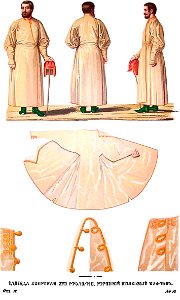Antiquities of the russian country, 1846-1853. Volume 4. Illustrator — ru: solntsev, fyodor grigorievich. Boyar clothing of the 17th century. Morning silk caftan although in the inscription this clothing is called a morning summer caftan, it most likely belongs to the ferez, which we touched on earlier. Ferez was men's and women's clothing; similar to it is found among the greeks, "underwear", according to gnedich's translation, "robe"; according to reif, "ferez" comes from the turkish - "cloak". In the old days, the russians called elegant sarafans ferez, which were warm and cold. The cut and size of the ferez is described to us in the cutting book from 7139 to 7146 as follows: "the ferez were cut for the tsar from taffeta ala vinitsa, taken from the treasury yard, the length of the ferez is two arshins, the width at the shoulders is an arshin and a vershok, the width at the hem is three arshins two vershok, the length of the sleeves is one and a half arshins, at the roots eight vershok, the width at the wrist is three vershok. " from this it is evident that the ferez differed from the caftan in its waist and sleeves, which were boron, wider at the roots, and narrower towards the wrist. Warm and cold ferez replaced caftans, which, as is known from the cutting books, were standard, riding, upper and lower, rain, with trims of upholstered, silk, with gold. They were decorated with ties with tassels and patterns, or circles, which were strung on velvet with pearls and precious stones. Alams, or collars, standing and lying, were fastened to them. The inventory of the household property of tsar ivan iv shows that ferezi were bought from the tatars, the shields were made of bur and kizilbash damask, i. E. Persian, often remade from platn, as were caftans with sleeves from ferezi. The decree of february 19, 1680 ordered "on the lord's and on the vladychny holidays and on the celebrations of special saints and the sovereign's exits, boyars, okolnichy, duma and close people, stolniks, solicitors, moscow nobles to be in gold and velvet and in ribandine ferezi. " the ferez was sometimes worn over the armour; its sleeves were slit and longer than those of the zipun and caftan. In the cutting book they are shown as 1 1/2 arshins long, and the ferez itself is 2 arshins long, 1 arshin 1 vershok wide at the shoulders, and 3 arshins 2 vershok wide at the hem. Date: between 1846 and 1853.
Loading...
